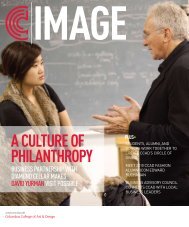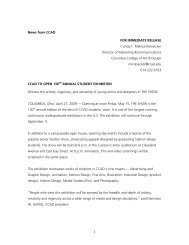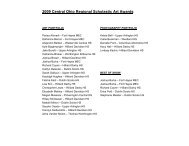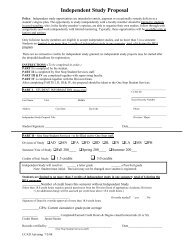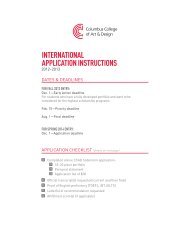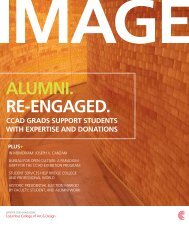STUDENT HANDBOOK - Columbus College of Art & Design
STUDENT HANDBOOK - Columbus College of Art & Design
STUDENT HANDBOOK - Columbus College of Art & Design
You also want an ePaper? Increase the reach of your titles
YUMPU automatically turns print PDFs into web optimized ePapers that Google loves.
ACADEMIC POLICIES AND PROCEDURES 05<br />
Residence Life 222.3294<br />
Safety & Security 222.6165<br />
Schottenstein Residence Hall Front Desk 222.3240<br />
Sciences Chair 437.7338<br />
Student Activities & Orientation 222.6191<br />
Student Affairs 222.4015<br />
Supply Store 222.3253<br />
Visual Communications Dean 222.3252<br />
Off Campus<br />
EMERGENCY (police, fire, or medical) 911<br />
Choices for Victims <strong>of</strong> Domestic Violence 224.4663<br />
Fire Department 221.2345<br />
HandsOn Central Ohio<br />
(community resource information) 221.2255<br />
Police Department (non-emergency) 645.4545<br />
Rape Crisis Hotline 267.7020<br />
Suicide Prevention 221.5445<br />
GRADUATION RATE<br />
CCAD’s four-year graduation rate is 49% and six-year<br />
graduation rate is 61%.<br />
ACCREDITATION AND AFFILIATIONS<br />
CCAD is accredited by the National Association <strong>of</strong> Schools<br />
<strong>of</strong> <strong>Art</strong> and <strong>Design</strong> and The Higher Learning Commission,<br />
North Central Association <strong>of</strong> <strong>College</strong>s and Schools. The<br />
Interior <strong>Design</strong> program is accredited by the Council for<br />
Interior <strong>Design</strong> Accreditation (CIDA). CCAD is affiliated with<br />
many academic organizations, including the Association <strong>of</strong><br />
Independent <strong>College</strong>s <strong>of</strong> <strong>Art</strong> and <strong>Design</strong>, the Association <strong>of</strong><br />
Independent <strong>College</strong>s and Universities <strong>of</strong> Ohio, the National<br />
Association <strong>of</strong> Foreign Student Affairs, and the New Media<br />
Consortium, which has designated the college a New Media<br />
Center.<br />
NONDISCRIMINATION STATEMENT<br />
CCAD admits students <strong>of</strong> any race, color, gender, religion,<br />
national and ethnic origin, disability, sexual orientation,<br />
veteran status, or age to all the rights and privileges,<br />
programs, and activities generally accorded or made<br />
available to students at the school. It does not discriminate<br />
on the basis <strong>of</strong> race, color, gender, religion, national or ethnic<br />
origin, disability, sexual orientation, veteran status, or age<br />
in administration <strong>of</strong> its educational policies, admissions<br />
policies, scholarship and loan programs and other schooladministered<br />
programs.<br />
ACADEMIC POLICIES<br />
AND PROCEDURES<br />
ATTENDANCE<br />
Students are required to attend all classes on their schedule.<br />
Students may receive a failing grade if they have three or<br />
more absences in courses meeting once a week or four<br />
or more absences in courses meeting twice a week. For<br />
Summer Semester, the number <strong>of</strong> absences is computed<br />
on the basis <strong>of</strong> the total number <strong>of</strong> class hours missed (nine<br />
or more hours for studio courses and six or more hours for<br />
other courses). For May Minimester or Summer Sessions,<br />
missing 15% or more <strong>of</strong> the classes may result in a failing<br />
grade. Students are reminded that they will receive a failing<br />
grade if they stop attending a course without properly<br />
dropping it. Dropping courses is the responsibility <strong>of</strong> the<br />
student.<br />
Absences are to be used only for sickness or for unusual<br />
situations when class attendance is not possible. Students<br />
are strongly advised to save their allowable absences for<br />
unforeseen circumstances.<br />
A student who is tardy three times in any course meeting<br />
once a week or six times in courses that meet twice a week<br />
may be charged one additional absence. Students arriving<br />
more than 30 minutes late may be marked absent. A student<br />
leaving a class early, without permission, may be considered<br />
absent. In the event that a faculty member is late to class,<br />
students are required to wait a minimum <strong>of</strong> 30 minutes for<br />
the instructor.<br />
EXCEEDING THE ABSENCE LIMIT<br />
Students who exceed the absence limit for a given course<br />
can ask One-Stop Student Services to verify an absence<br />
due to an unforeseen or unavoidable circumstance. If the<br />
verification is provided, the instructor will receive notice<br />
from One-Stop Student Services regarding the reason for the<br />
absence. However, it is ultimately the instructor’s decision<br />
to determine the consequences <strong>of</strong> that absence, even if it is<br />
due to an unforeseen circumstance. Additionally, the student<br />
will not be excused from tests, in-class assignments, or<br />
homework assignments as a result <strong>of</strong> any absence.<br />
Unforeseen or unavoidable circumstances include<br />
hospitalization, funeral <strong>of</strong> an immediate family member,<br />
traffic accident, military service, or medical emergency.<br />
Unacceptable situations for absence include a scheduled<br />
appointment with a doctor for general health issues, chronic<br />
health conditions, any routine sicknesses that do not require<br />
hospitalization or quarantine (such as a cold, headache, sore



